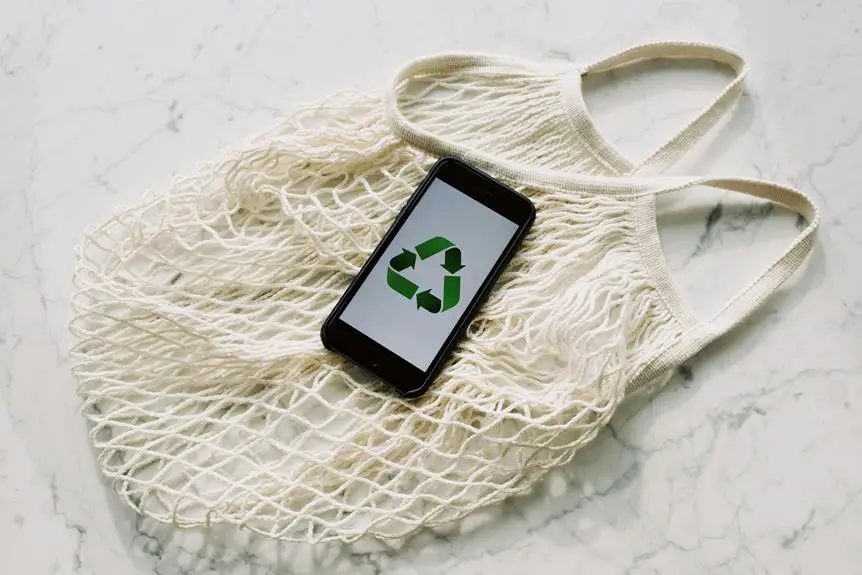You might find yourself considering the role of waxed fabrics in the evolving landscape of sustainable design. As brands shift towards transparency and circular principles, these materials could become more than just a trend; they might redefine how we think about durability and style. Innovations in biodegradable waxes and collaborations with local artisans hint at a future where aesthetic appeal meets ethical responsibility. But how will these changes influence consumer choices and industry standards? Exploring these questions could reveal insights that challenge your current perceptions.
Table of Contents
Key Takeaways
- Increased integration of biodegradable wax alternatives will enhance eco-friendliness while reducing landfill waste in waxed fabric production.
- Brands will prioritize transparency in sourcing and production processes, fostering consumer trust and accountability.
- The use of sustainable materials like organic cotton and hemp will grow, minimizing environmental impact and supporting local economies.
- Innovations in advanced coating techniques will improve durability and functionality without compromising on design aesthetics.
Understanding Waxed Fabrics
Waxed fabrics, known for their durability and water resistance, are gaining popularity in sustainable design due to their eco-friendly properties. These materials, often made from cotton or linen, undergo a waxing process that enhances their strength and functionality. When you choose waxed fabrics, you're opting for a product that not only resists moisture but also lasts longer than many conventional textiles.
The waxing treatment involves applying natural beeswax or paraffin to the fabric, creating a barrier that protects against water. This process minimizes the need for synthetic waterproofing chemicals, making waxed fabrics a greener choice. You might appreciate how their breathable nature allows for comfort while still providing protection from the elements.
Additionally, waxed fabrics are easy to clean and maintain. You can simply wipe off dirt and grime, prolonging the life of your items.
With their unique texture, these materials also offer a stylish aesthetic, making them suitable for various applications, from outerwear to bags. By incorporating waxed fabrics into your wardrobe or home design, you're contributing to a more sustainable future while enjoying functionality and style.
Historical Significance of Waxed Fabrics
Historically, these unique fabrics have been used for centuries in various cultures, providing durable and water-resistant solutions for clothing and gear.
You might find it fascinating that ancient mariners utilized waxed canvas to protect their sails from the elements, ensuring they could navigate harsh waters. This practice didn't just stop there; artisans in different regions adopted similar techniques, enhancing their local textiles with natural waxes for added resilience.
In colder climates, people often relied on waxed fabrics to create outerwear that could withstand the rigors of winter. You can see how this innovation was essential for survival, allowing communities to thrive in challenging environments. Waxed fabrics also played a significant role in the development of outdoor gear, from tents to backpacks, as explorers ventured into uncharted territories.
As you reflect on this historical significance, consider how these time-tested materials have shaped not only functional design but also cultural identity. The tradition of using waxed fabrics highlights a deep understanding of nature's elements, showcasing human ingenuity in creating protective solutions.
This rich history sets the stage for today's sustainable design practices, reminding us of the importance of durability and functionality in our materials.
Benefits of Waxed Fabrics in Design
Incorporating waxed fabrics into design not only enhances durability and water resistance but also promotes sustainability by extending the lifespan of products. When you choose waxed fabrics, you're opting for materials that withstand the rigors of daily use, making them ideal for bags, clothing, and outdoor gear. Their natural resistance to moisture means you won't have to worry about water damage, reducing the need for frequent replacements.
These fabrics can also be easily cleaned and maintained, which saves you time and effort. Plus, their unique texture and aesthetic appeal add a distinctive character to your designs, allowing you to stand out in a crowded market. Waxed fabrics age beautifully, developing a patina that tells a story and showcases their durability.
Moreover, by using waxed fabrics, you're supporting eco-friendly practices. Many manufacturers source organic cotton or hemp, reducing the environmental footprint associated with conventional textiles. This commitment to sustainability resonates with consumers who prioritize ethical choices.
In essence, waxed fabrics offer a perfect blend of functionality, style, and environmental responsibility, making them a smart choice for any designer focused on sustainable design principles.
Innovations in Waxed Fabric Production
In today's world, you're likely looking for ways to make your fabric choices more sustainable.
Innovations in waxed fabric production are leading the way, integrating eco-friendly materials and advanced coating techniques.
Plus, the emergence of biodegradable wax alternatives is transforming how you think about durability and environmental impact.
Eco-Friendly Materials Integration
As designers seek sustainable solutions, innovations in the production of waxed fabrics are transforming how eco-friendly materials are integrated into modern textiles.
You'll find that today's waxed fabrics often utilize organic cotton, hemp, or recycled fibers, reducing their environmental impact. These materials not only minimize reliance on conventional, resource-intensive textiles but also enhance the durability and longevity of the final products.
Furthermore, advances in natural waxes and oils are leading to less harmful chemical use. Instead of traditional paraffin waxes, many manufacturers now favor plant-based alternatives like beeswax or soy wax, which are biodegradable and renewable.
This shift allows you to create products that aren't only stylish but also support ecological balance.
Advanced Coating Techniques
Advanced coating techniques are revolutionizing the production of waxed fabrics, enhancing their functionality and appeal while maintaining a commitment to sustainability. These innovations allow you to create fabrics that aren't only water-resistant but also breathable, ensuring comfort without compromising on performance.
One notable advancement is the use of nano-coatings, which provide an ultra-thin layer of protection without adding bulk. These coatings can repel water and dirt, keeping your fabric looking fresh and new for longer periods. Plus, they're often made from eco-friendly materials, aligning with your sustainable design goals.
Another exciting technique involves the incorporation of natural waxes blended with advanced polymers. This combination results in a durable, flexible fabric that mimics the traditional waxed feel while reducing reliance on petroleum-based products. You'll find that these fabrics are easier to maintain and can withstand harsher conditions.
As you explore these advanced coating techniques, you'll discover that they not only enhance the aesthetic qualities of waxed fabrics but also elevate their performance. This approach promises a future where style and sustainability go hand in hand.
Biodegradable Wax Alternatives
Biodegradable wax alternatives are transforming the landscape of waxed fabric production, offering eco-friendly solutions that align with your sustainable design principles. By utilizing natural materials, these alternatives not only reduce environmental impact but also enhance the functionality and aesthetic appeal of your designs.
Here are three key benefits of biodegradable wax alternatives:
- Environmental Impact: These waxes decompose naturally, reducing landfill waste and pollution, which is essential for a sustainable future.
- Versatility: You can use biodegradable waxes for various applications, from clothing to accessories, allowing you to maintain a consistent eco-friendly ethos across your product lines.
As you explore these innovative materials, you'll find that they not only align with your values but also offer exciting possibilities for creativity.
Embracing biodegradable wax alternatives can set you apart in the competitive market, showcasing your commitment to sustainability while delivering high-quality products that consumers appreciate.
It's time to rethink your materials and contribute positively to the planet.
Ethical Sourcing and Sustainability
When you think about ethical sourcing, consider how raw materials are obtained and the impact on the environment.
You'll want to explore eco-friendly production processes that prioritize sustainability.
Transparency in supply chains is also crucial, as it helps you make informed choices about the fabrics you use.
Sourcing Raw Materials Responsibly
Sourcing raw materials responsibly is crucial for ensuring that the production of waxed fabrics aligns with sustainable design practices. You want to make sure that the materials you choose not only reduce environmental impact but also support ethical labor practices. By prioritizing responsible sourcing, you can contribute to a more sustainable future.
Consider these key factors when sourcing raw materials for waxed fabrics:
- Organic and Natural Fibers: Opt for fibers like organic cotton or hemp, which require fewer pesticides and water compared to conventional materials. This choice promotes eco-friendliness and supports biodiversity.
- Local Sourcing: Whenever possible, source materials locally to minimize transportation emissions. This not only reduces your carbon footprint but also strengthens local economies and fosters community relationships.
Eco-Friendly Production Processes
Choosing eco-friendly production processes is just as important as sourcing raw materials responsibly, as they directly impact the overall sustainability of waxed fabric production. By opting for methods that minimize environmental harm, you can significantly reduce the carbon footprint of your products.
Start by selecting manufacturers who prioritize renewable energy in their operations. This not only decreases reliance on fossil fuels but also enhances the overall green credentials of the fabric.
Look for processes that utilize water-based waxes instead of solvent-based alternatives, as these reduce harmful chemical emissions and enhance worker safety.
It's equally vital to ensure that the dyeing and finishing processes are free from toxic chemicals. Many manufacturers now offer non-toxic, biodegradable options that maintain fabric quality while being gentler on the environment.
Additionally, consider production methods that minimize waste, such as zero-waste cutting techniques or recycling scraps into new materials.
By taking these steps, you're contributing to a more sustainable future for waxed fabrics, ensuring that both your designs and practices reflect your commitment to eco-friendliness.
Embracing these eco-conscious production processes can set you apart in the increasingly competitive sustainable design market.
Transparency in Supply Chains
Transparency in supply chains is essential for ensuring ethical sourcing and sustainability in waxed fabric production. You need to know where your materials come from and how they're made. This clarity not only builds trust with consumers but also holds manufacturers accountable for their practices.
When you choose waxed fabrics, you're making a statement about your values, and you want to support brands that align with those beliefs.
Here are a few key aspects to consider regarding transparency in supply chains:
- Material Sourcing: Understand the origins of the cotton or other materials used, ensuring they're sourced from farms that prioritize sustainable practices.
- Production Processes: Look for information on how the fabrics are treated and waxed, ensuring non-toxic and eco-friendly methods are used.
Waxed Fabrics in Fashion Trends
Waxed fabrics are making a bold statement in fashion trends, effortlessly blending durability with style. You'll find these materials in everything from jackets to bags, appealing to those who crave functionality without sacrificing aesthetics. Designers are embracing waxed fabrics for their unique texture and weather-resistant properties, making them ideal for both casual and high-fashion looks.
You can easily spot waxed cotton in outdoor gear, where its resilience stands up to the elements. However, it's also infiltrating urban fashion, showing up in chic trench coats and stylish accessories. This versatility means you can dress it up or down, depending on the occasion.
Moreover, waxed fabrics are becoming a favorite among eco-conscious consumers. Many brands are opting for sustainable wax finishes, ensuring that you support ethical fashion while looking great. When you choose waxed fabrics, you're not just making a style choice; you're also investing in longevity.
As you navigate the latest trends, consider incorporating waxed fabrics into your wardrobe. They're not just a seasonal fad—they're a smart, stylish solution that complements your lifestyle while keeping sustainability in mind.
Future Trends in Sustainable Design
Embracing innovative materials and practices, designers are set to redefine sustainability in the fashion industry, pushing boundaries to create eco-friendly solutions that resonate with conscious consumers.
As you explore future trends, you'll find a shift towards transparency, circularity, and community-driven initiatives.
- Transparency: Brands will prioritize open communication about sourcing, production methods, and environmental impact, allowing you to make informed choices.
- Circularity: Expect a rise in designs that promote reusability and recyclability, ensuring that products don't end up as waste but instead can be reimagined or regenerated.
Frequently Asked Questions
Are There Any Health Concerns Associated With Waxed Fabrics?
Yes, there can be health concerns with waxed fabrics. Some coatings may contain harmful chemicals, and prolonged exposure can cause skin irritation or allergies. Always check product labels and choose ones made from safer, non-toxic materials.
How Do Waxed Fabrics Compare to Synthetic Alternatives?
When you compare waxed fabrics to synthetic alternatives, you'll find waxed fabrics offer breathability and natural water resistance. Synthetic options might excel in durability and cost, but they often lack the eco-friendliness of waxed materials.
Can Waxed Fabrics Be Recycled or Composted?
Waxed fabrics aren't typically recyclable or compostable due to their coatings. You might find some brands offering more eco-friendly options, but generally, it's best to check with manufacturers for specific disposal guidelines.
What Maintenance Do Waxed Fabrics Require Over Time?
Waxed fabrics need regular care to maintain their durability. You should clean them with a damp cloth and mild soap, reapply wax every few months, and avoid excessive heat to prolong their life and functionality.
Are There Specific Care Guidelines for Washing Waxed Fabrics?
When washing waxed fabrics, you should avoid machine washing. Instead, wipe them with a damp cloth and mild soap. If necessary, reapply wax after cleaning to maintain water resistance and preserve the fabric's integrity.
- How Does Ring Spun Cotton Affect Garment Fit and Shape Retention? - August 13, 2024
- What Are the Challenges in Producing Ring Spun Cotton? - August 13, 2024
- Is Ring Spun Cotton Suitable for Plus-Size Clothing? - August 13, 2024





